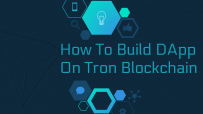
How To Create ADA Token On Cardano Blockchain
Subscribe
Cardano is one of the most promising blockchain projects in the market today. It is among the top cryptocurrencies in the world, with a market cap of over 43 billion dollars. Native tokens provide multi-asset support to Cardano, which enables users to build custom tokens and conduct transactions using those on the Cardano blockchain. Tokens can cut costs and improve transparency, and liquidity. They are also independent of the control of centralized entities like banks. Token development on Cardano is very much in demand today. Let’s have a look at how to create ADA tokens on the Cardano blockchain.
What is Cardano?
Cardano is a 3rd generation, decentralized Proof of Stake blockchain platform aiming to be a substitute to Proof of Work networks. Scalability, interoperability, and sustainability on Proof of Work blockchains like Ethereum are restricted by the infrastructure limitations of mounting costs, energy consumption, and delayed transaction times. Cardano deploys a two-tiered network, which renders faster transaction processing time. Some of the benefits of Cardano:- Quick Transactions
- Cost-Effective
- Scalability
- Traceability
- Interoperability
- Multi-asset Capability
- High Security
Read Tron Crypto Token Development And Its Benefits
Tokens in Cardano
Developers, businesses, and applications are making fungible and non-fungible tokens on the Cardano blockchain. These tokens are used as custom payment tokens, rewards in Dapps, stable coins linked with other currencies, or assets that represent intellectual property. The ERC20 tokens of Ethereum are based on Ethereum smart contracts. But the tracking and accounting of custom tokens are supported by the Cardano blockchain natively. Because of this users can send, receive, and burn their tokens without any transaction fees for smart contracts or tracking transactions.Token development on Cardano Blockchain
Cardano provides a simple, affordable, and secure environment for token development. Users can choose from three ways to create, distribute, exchange, and store tokens according to their preferences and technical expertise. The three ways are:- Cardano command-line interface (CLI)
- Graphical User Interface (GUI)
- The Daedalus Wallet
Cardano Command-line Interface (CLI)
Experienced developers can utilize the native tokens testing environment to mint assets and send test transactions to various addresses. Users have to be accustomed to setting up and operating the Cardano node and have experience in managing transactions, addresses, and values. The steps involved are:- Setup and start the Cardano node
- Configure a relay node to link to the native tokens testing environment
- Begin interaction with the network
- Create a monetary policy script
- Develop tokens using the monetary policy script
- Submit and sign transactions to transfer tokens
Graphical User Interface (GUI)
The command-line interface needs a certain level of development expertise. There are ways for less technically skilled users to develop tokens. The token builder graphical user interface(GUI) makes the creation of tokens easier. If you want to create tokens for your dapp, tokenize your property, create NFT collector cards, or want to create a stable coin linked to the price of other currencies, the token builder can help you do that. To create a token you just need to fill in:- The token name
- The token symbol
- The token icon that can be generated automatically
- Amount to create
- Cardano wallet address
Daedalus
Users who do not want to create their own tokens but use existing ones for payments, purchases or trades, can use wallets like Daedalus and Yoroi. Daedalus works on linking the wallet backend with the UI to maintain the native token functionality. This will enable users to hold, send and receive native tokens from their wallets as they do with ADA. Native tokens are uniquely distinguished by two hexadecimal numbers stored on the chain. These two hexadecimal numbers are the Policy ID and the Asset Name. As these numbers are difficult for people to remember there are fingerprints for easier identification of native tokens. A fingerprint is a 44 character lengthy alphanumeric string starting with the title ‘token’. Extra token data shown in the wallet UI such as name, description, and acronym will be given by the Cardano token registry, managed initially by the Cardano Foundation.Conclusion
The Cardano blockchain is perfect for the most advanced innovations in the crypto industry such as DeFi and NFT. These are the three ways you can create tokens on the Cardano blockchain. As Cardano is considered a promising project with solid fundamentals and a good plan for the future, developing your tokens on the blockchain can be a good move. Cryptosoftwares can help you develop your tokens on the Cardano blockchain.Explore more about Solana Token Development
- What is Cryptojacking? Detection and Preventions Techniques
- How to Give Cryptocurrency As a Gift?
- Blockchain Development Life Cycle – Step by Step Guide
- How To Hire A Blockchain Developer For Your Company
- How to Choose the Right Bitcoin Development Company – A Complete Guide
- Common Bitcoin Scams – Beware Of Fraudsters
- How can entrepreneurs leverage blockchain in 2023?
- Role of Blockchain in Cyber Security
- Document and Certificate Verification Through Blockchain Technology
- Initial Coin Offering (ICO): Everything you need to know in 2023
- Categories
- Azure Blockchain Service
- Bitcoin
- Bitcoin Development
- Blockchain Application
- Blockchain Application Development
- blockchain developer
- Blockchain Development
- common bitcoin scams
- Crypto software features
- Crypto softwares
- Cryptocurrency
- Cryptocurrency Development
- Cryptocurrency Exchange Software Development
- Cryptocurrency review
- Cryptocurrency Trading
- Cryptocurrency Wallet Development
- ERC20 Token Development
- Hashing Algorithm
- ICO Development
- ICO Development Service
- ico website development
- Proof of Stake Coins
- Smart Contract Development
- Uncategorized













Leave a Reply